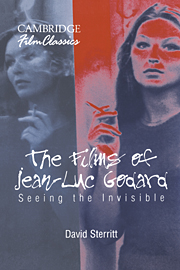8 - Video and Television
Published online by Cambridge University Press: 12 January 2010
Summary
And if cinema today still works on television, it's because television itself has no love. …On television you can find power in its pure state, and the only things that people like seeing on TV at all are sports and cinema films, and that is because they seek love….
–Jean-Luc Godard, 1983Godard's interest in video, including mass-market television and offbeat “video art” formats, did not grow into a strong preoccupation until the middle of the 1970s. This makes him something of a latecomer to the field, since alternative or “guerrilla” television had already picked up a good deal of steam among American artists and activists.
It goes without saying that his tardiness was not caused by timidity or conservatism. The main thing at issue was his longstanding loyalty to the apparatus of motion pictures: the professional 35mm equipment he had worked with during most of his career, and the flexible 16mm format (carrying many of the benefits associated with portable TV equipment) used for many of the Dziga-Vertov Group films.
His first production using video as a major tool was Numèro deux in 1975. This was a full five years after the American video underground had started its efforts to satirize, subvert, and ultimately replace the establishment-bound institutions of commercial TV, inspired by the countercultural mood of the 1960s in general, and the writings of fashionable theorists like Marshall McLuhan and Buckminster Fuller in particular.
- Type
- Chapter
- Information
- The Films of Jean-Luc GodardSeeing the Invisible, pp. 247 - 264Publisher: Cambridge University PressPrint publication year: 1999

